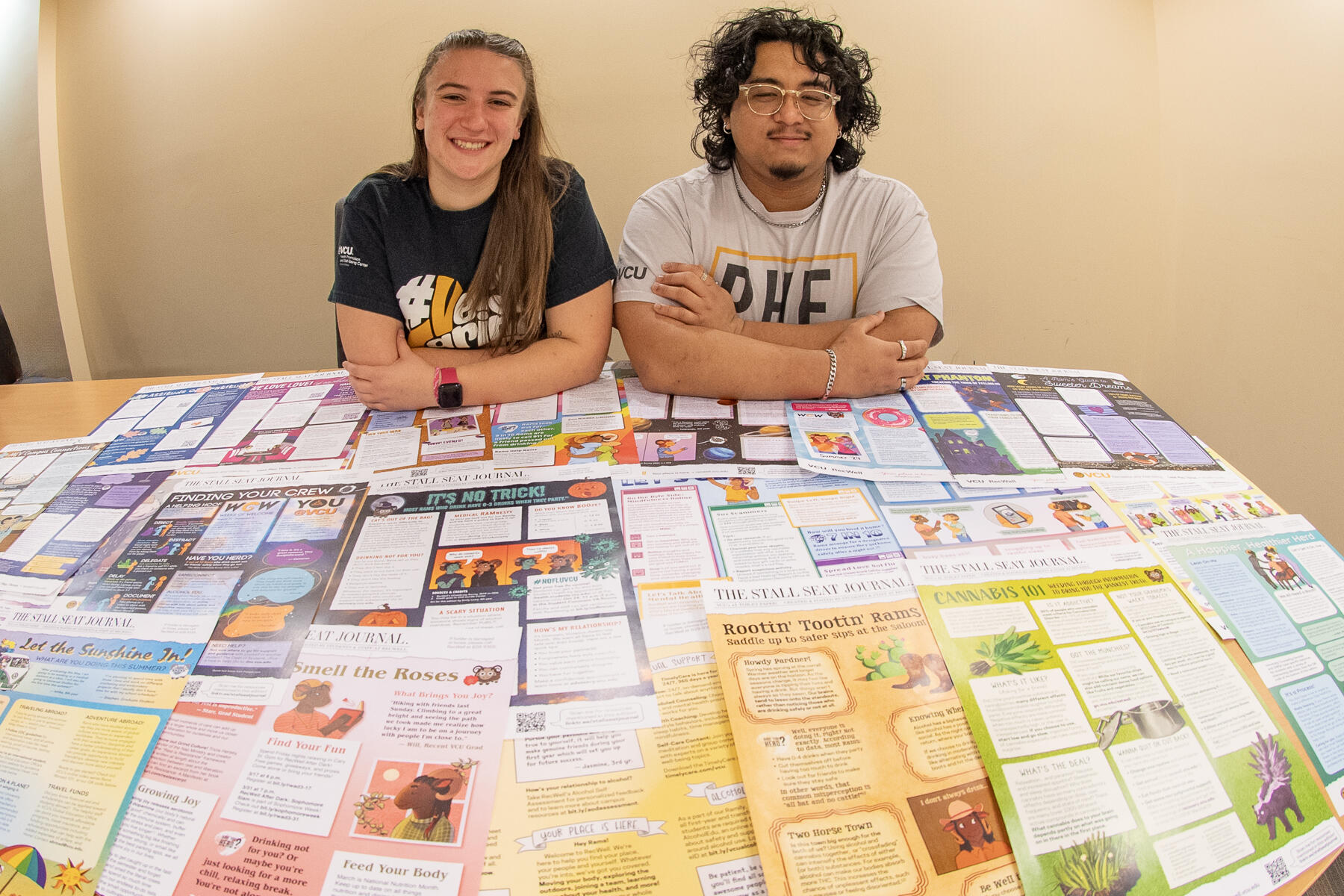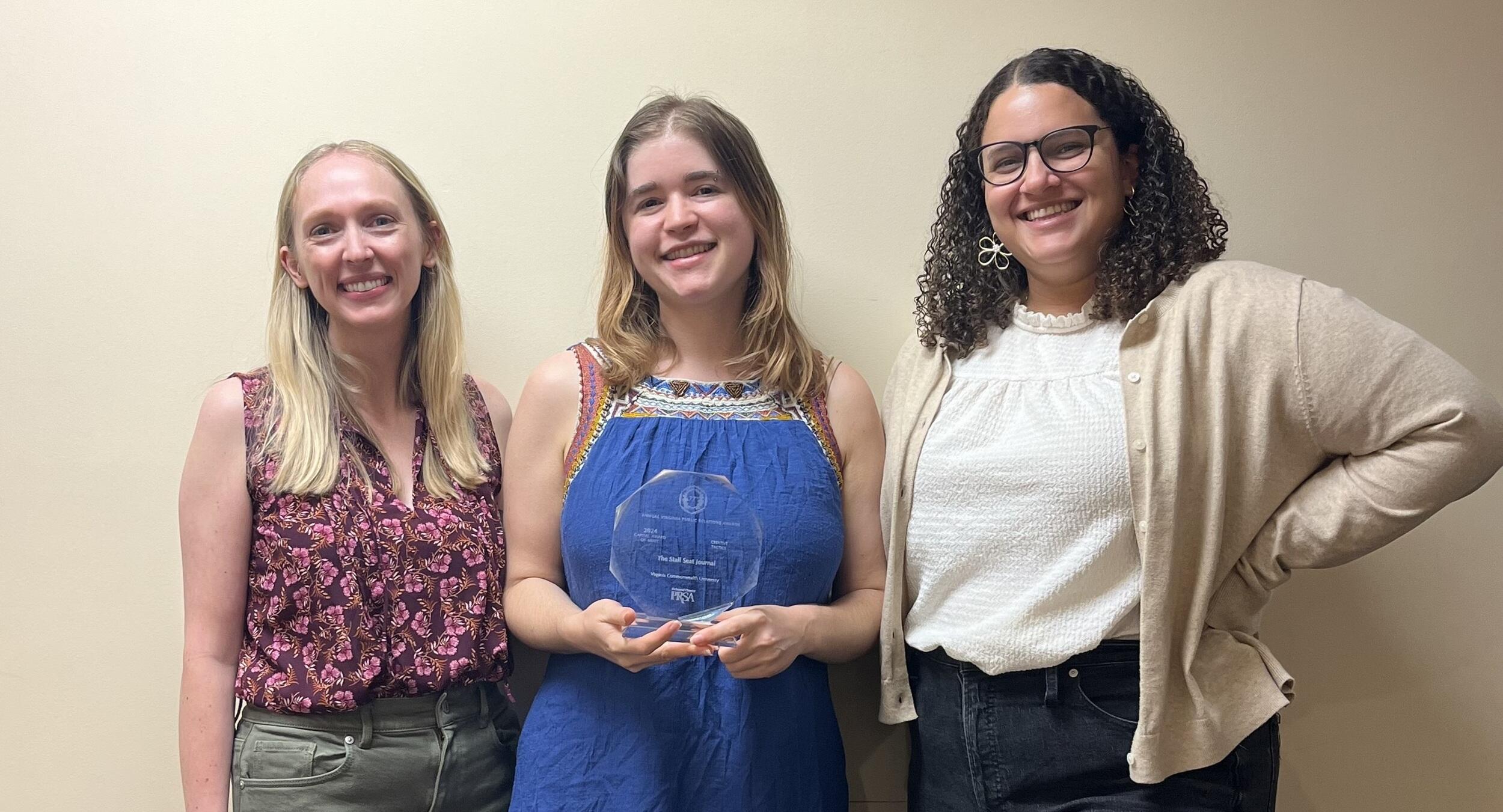
Jan. 13, 2025
The Stall Seat Journal is the power in front of the throne
Share this story
If you’ve used the bathroom at Virginia Commonwealth University, you’ve likely seen the Stall Seat Journal.
Plastered in more than 1,300 stalls on the Monroe Park and MCV campuses, the monthly informational poster – full of color and personality – discusses student health and safety and shares helpful resources. The Stall Seat Journal proudly touts itself as “VCU’s #1 Toilet Paper!” and its captive audience is so dedicated that sometimes editions are stolen from stalls at the end of the month.
“I think it’s a huge compliment,” said Mia Liadis, assistant director for health promotion with Recreation and Well-Being and adjunct faculty with the School of Education.
Another compliment, beyond the bathroom: The Stall Seat Journal was honored in the category of creative tactics at last year’s Virginia PR Awards.

Founded in 2001, the Stall Seat Journal is seriousness with style. As a public health campaign from RecWell, it promotes healthy practices among students and corrects misperceptions about potentially risky behaviors, such as consistent partying and engaging in substance use. The creators use surveys and data to determine topics, and to avoid sounding “preachy,” they emphasize facts that can inform students’ decision-making.
The publication’s personality is geared to the student audience, too. Emily Tompkins, health communications coordinator with the Division of Student Affairs, said she remembers reading the Stall Seat Journal as a freshman and actually enjoying it, which can be unusual for public health campaigns that target young adults.
“It’s an institution,” she said. “People like cartoons. They like the relatable voice, the tips and the nonjudgment of it all.”

A bit of learning – and laughter
Linda Hancock, one of the Stall Seat Journal founders, wanted to put an “aha” and a “haha” in every edition – “something new that you haven’t heard of before and something that makes you laugh,” according to Tompkins. “We still try to make that happen.”
A big part of that is the iconic comics, which are populated by rams. While in earlier editions they stood on four legs, they have become bipedal over the years and even wear full outfits.
Styles have varied based on different illustrators. For the past few years, many comics in the Stall Seat Journal have been created by Emily Leary, who graduated from the School of the Arts in 2023. (Tompkins was the first artist to clothe the characters after Trisha Saunders, associate director for programs and assessment at RecWell, told her “to put pants” on the rams.)
Guidelines now call for the rams to be characters with their own personalities, and that they reflect diversity and interesting clothing – much like VCU’s student body. Tattoos, piercings, mobility aids and more are among the characters’ features.

“Our students are always telling us, ‘The thing I love about VCU the most is the diversity,’ and so we want that to be reflected in our rams as well,” said Starr Robinson, health promotion specialist for coaching and programs with RecWell. “We want students to feel like they’re reflected in the work so that there is that level of connection of, ‘Oh, that ram kind of looks like me.’”
They noted that like the art, the tone of the Stall Seat Journal has shifted over the years toward messaging that is more “PIE” – positive, inclusive and empowering. The fact-forward approach is paired with attention to wellness topics that often have carried judgments about one’s health and habits, and “it’s really difficult to grow through shame,” Robinson said.
“So we want to ensure that our students – and even our campus partners, faculty, staff – know that we’re here providing that foundation of information, and we’re here to support you regardless of what you decide to do with it,” they said.
While the framework has evolved to be more inclusive and compassionate, the journal was founded with a desire to help and inform students rather than preach or shame.
“The theme of it has changed but the heart of it has always been the same,” Liadis added. “How do we create that spark that makes it fun and enjoyable to read?”
A proper meeting place
Of course, one reason the Stall Seat Journal connects with readers is because in a world of workshops, newsletters, emails and tweets, it cuts through the noise and meets people where they are.
“Everything is so saturated with email and social media – everybody’s on everything, which means nobody’s on everything,” Tompkins said. “We’re always in the bathroom, and everybody goes to the bathroom. It’s the great equalizer.”
“I feel like our students are at the center of the Stall Seat and it wouldn't exist if they weren't there.”
Starr Robinson, health promotion specialist and coaching & programs with RecWell
Planning for the journal’s yearly schedule starts in the summer, with staff determining what themes and topics will be covered each month. Organizers review surveys of students and their health behaviors, particularly VCU’s UCelebrate! survey as well as the National College Health Assessment. Ucelebrate! focuses on alcohol use and NCHA asks students about substance use, mental health, sexual health, physical health and nutrition.
“And it’s a random sample, so we get a good idea of a diverse student experience at VCU,” Liadis said.
The team prioritizes trends they see in higher education as well as ideal timing for each topic. For example, near fall break and the holiday season when students often return home, the Stall Seat Journal may spotlight food security resources.
Production for each edition starts roughly four to six weeks before the poster reaches a toilet stall. The writing, illustrating and vetting require multiple layers of review.
Once the final product is ready, interns in VCU’s health sciences unit put up almost all of the fliers across both campuses, and they replace damaged holders. This is no small task. For example, the Stall Seat journal is posted in 402 stalls across the MCV campus alone.

Those interns also are students themselves, with insight into what topics (and even what slang) might connect best with their peers. They also offer honest feedback on if a joke will land and if an edition can be more inclusive and empowering.
Robinson said the Stall Seat would not exist without its student interns.
“From posting the editions across campus, to editing and providing quotes for the Stall Seat Journal, they are an essential part of the process,” they said.
And student contributions to the Stall Seat Journal don’t stop after graduation. Liadis, Robinson and Tompkins are all VCU alums.
“It’s a gift to be able to work on something that has been a standing campaign for over 20 years,” Liadis said, “coming from reading it as a student to being involved in it as a staff member.”
Subscribe to VCU News
Subscribe to VCU News at newsletter.vcu.edu and receive a selection of stories, videos, photos, news clips and event listings in your inbox.










